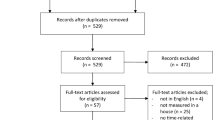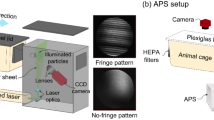Abstract
SEVERAL workers have investigated the numbers and sizes of droplets expelled during expiratory manoeuvres such as coughing or sneezing. When droplets are recovered by settling, by impaction or by some form of air sampler, it is necessary to calculate the airborne diameter of the original droplet from the diameter of the stain left after recovery. Duguid1 repeated the experiments of Strauss2 in which large droplets of saliva (1–3 mm in diameter) were measured with a micrometer eyepiece, first while they hung from fine glass capillaries and then again after they had fallen, flattened and evaporated on a slide. When a glass slide was used, the diameters of the original droplets were about half those of the stain marks. Buckland and Tyrrell3, using glass slides, calculated the airborne diameter of droplets as 1/2.5 of the diameter of the stain marks left after impaction. May4 described the use of glass slides coated with magnesium oxide in estimating the airborne diameter of droplets; droplets landing on this surface will penetrate the magnesium oxide crust like stones falling into snow, and the diameter of the entry-hole is related to the airborne diameter of the droplet. He investigated this relationship for droplets with airborne diameters ranging from 20µ to 250µ, determining the airborne diameter by an “absolute method” which involved trapping the droplet in oil, and measuring it microscopically5. He concluded that the airborne diameter averaged 0.858 times the magnesium oxide entry-hole diameter, and that this relationship was independent of the speed of impaction and, within the range investigated, of the diameter of the droplet involved.
This is a preview of subscription content, access via your institution
Access options
Subscribe to this journal
Receive 51 print issues and online access
$199.00 per year
only $3.90 per issue
Buy this article
- Purchase on Springer Link
- Instant access to full article PDF
Prices may be subject to local taxes which are calculated during checkout
Similar content being viewed by others
References
Duguid, J. P., J. Hyg., Camb., 44, 471 (1946).
Strauss, W., Z. Hyg., 105, 416 (1926).
Buckland, F. E., and Tyrrell, D. A. J., J. Hyg., Camb., 62, 365 (1964).
May, K. R., J. Sci. Instrum., 22, 187 (1945).
May, K. R., J. Sci. Instrum., 27, 128 (1950).
Wolf, W. R., Rev. Sci. Instrum., 32, 1124 (1961).
Ostle, B., Statistics in Research, 159 (Iowa State University Press, Ames Iowa, 1963).
Author information
Authors and Affiliations
Rights and permissions
About this article
Cite this article
LOUDON, R., ROBERTS, R. Relation between the Airborne Diameters of Respiratory Droplets and the Diameter of the Stains left after Recovery. Nature 213, 95–96 (1967). https://doi.org/10.1038/213095a0
Issue Date:
DOI: https://doi.org/10.1038/213095a0
This article is cited by
-
Bacterial survival in evaporating deposited droplets on a teflon-coated surface
Applied Microbiology and Biotechnology (2006)
Comments
By submitting a comment you agree to abide by our Terms and Community Guidelines. If you find something abusive or that does not comply with our terms or guidelines please flag it as inappropriate.



